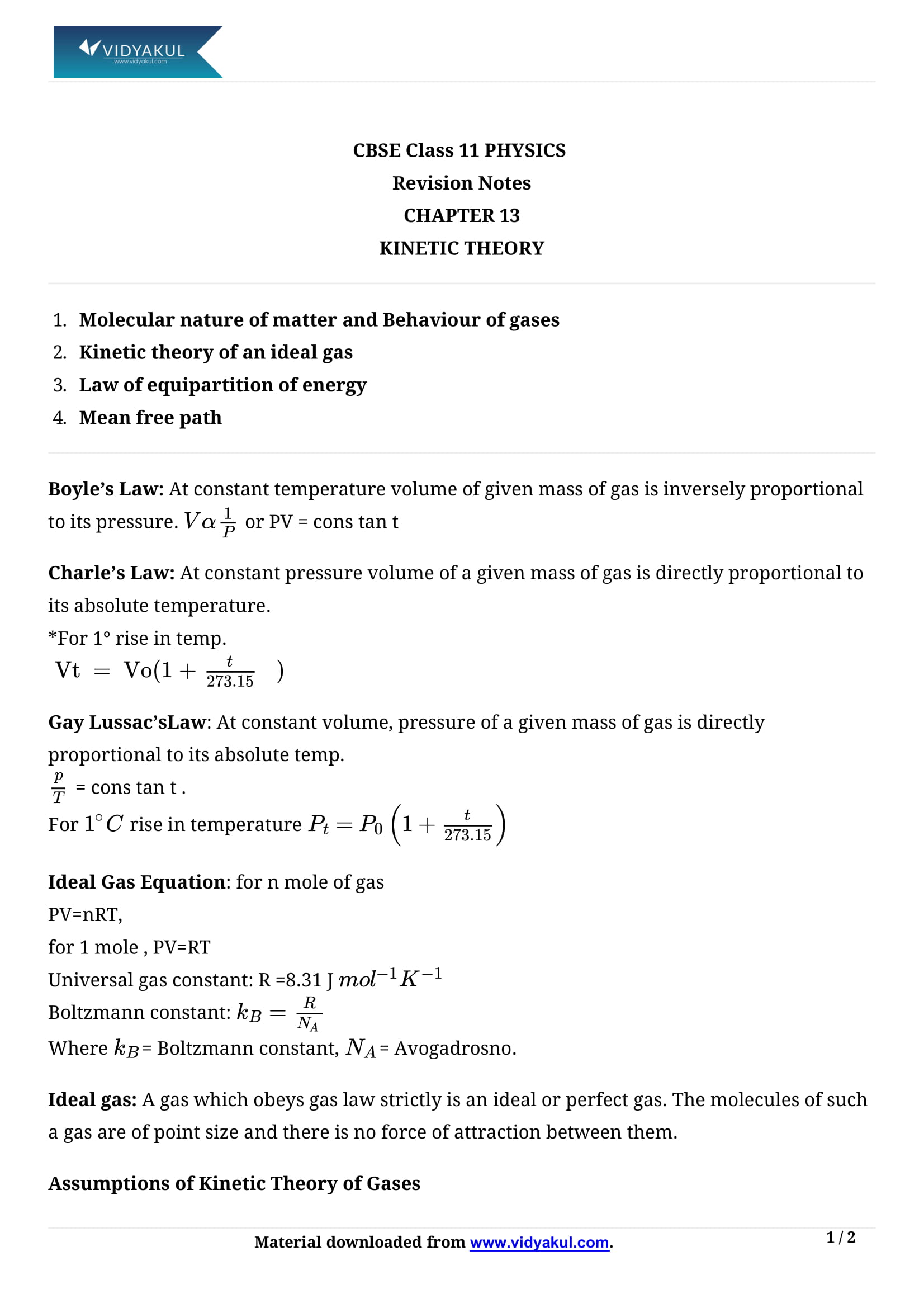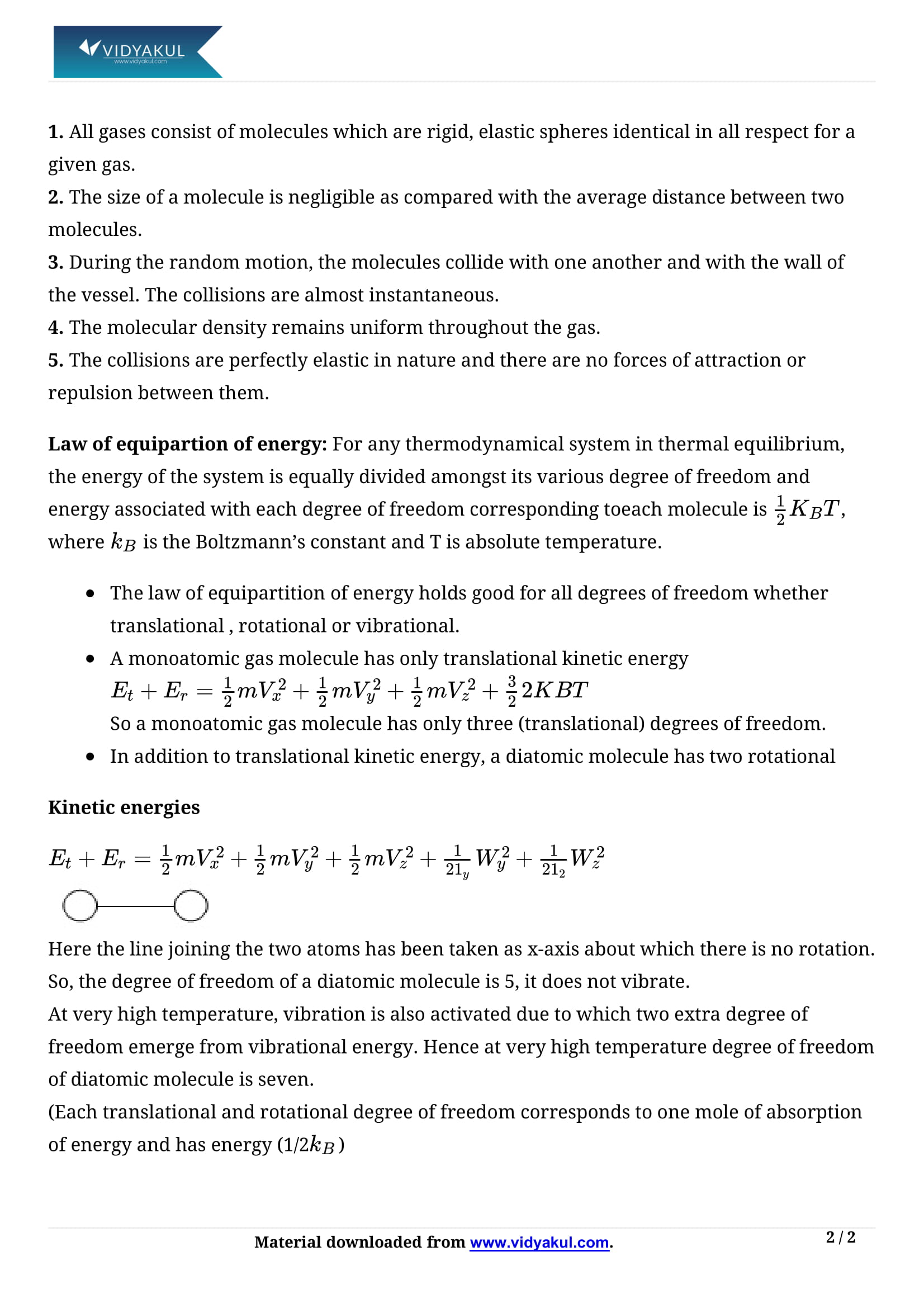Class 11 Physics Chapter 13 Kinetic Theory Notes

Chapter 13 Kinetic Theory
NCERT Physics Chapter 13 Kinetic Theory is an important resource to help students do well on exams. Chapter 13 Kinetic Theory is important because it introduces students to the basic concepts that will be tested on the entrance exam. NCERT notes include detailed explanations and accurate answers to help students understand concepts and pass exams.
CBSE Class 11 Chapter 13 explains the molecular properties of matter, the behavior of gases, the kinetic theory of ideal gases, and the law of the equal division of energy. Vidyakul provides a set of over 480 exercises covering all subtopics in Chapter 13. Students should practice all text questions and do well on the exam. In this article, students can find NCERT notes on any problem in Kinetic Theory.
CBSE CLASS 11th PHYSICS CH-13
Points to Remember
Some of the crucial points related to NCERT Class 11 Physics Chapter 13 Kinetic Theory are mentioned below:
Avogadro’s Hypothesis: Equal volumes of all gases under similar conditions of temperature and pressure have the same number of molecules.
Graham’s law of diffusion of gasses: The rate of diffusion of a gas is inversely proportional to the square root of the density of the gas.
Dalton’s law of partial pressure: The resultant pressure exerted by a mixture of non‐interacting gases is equal to the sum of their individual pressures.
PV =nRT, an ideal gas equation for n moles of gas.
Mean or average K.E. of a molecule of a gas =3/2kT
Degree of freedom for a monoatomic gas, f=3, for diatomic gas molecule, f=5 at room temperature.
Boyle’s law: The volume of a given mass of a gas is inversely proportional to the pressure of the gas, provided the temperature of the gas is constant. PV=Constant or P1V1=P2V2 if T= Constant.
Charle’s law: The volume of a given mass of a gas is directly proportional to the temperature of the gas, provided the pressure of the gas is constant. V/T = Constant or V1/T1=V2/T2 if P is constant.
Topics and Sub-topics
Kinetic theory is one of the fundamental topics in physics that helps students build the foundation they need to understand complex topics in the future. Students should become familiar with formulas in order to solve problems. Students will have to face a variety of problems to understand their approach to problem-solving.
The list of topics present in Class 11 Physics Chapter 13 is mentioned below:
Few Important Questions
What is the Ideal gas equation?
The ideal gas law (PV = nRT) relates to the macroscopic properties of ideal gases.
What does the ‘Molecular theory of gases’?
The Kinetic Molecular Theory explains the forces between molecules and the energy that they possess.
How many gas laws are present?
Gas Laws: Boyle’s Law, Charle’s Law, Gay-Lussac’s Law, Avogadro’s Law.
Practice Questions
Find out the ratio of the molecular volume to the actual volume occupied by the molecules of oxygen gas at STP. Let’s assume the diameter of an oxygen molecule to be 3 Å.
When 1 mol of any gas has a molar volume of 13.2 at standard temperature and pressure (STP: 1 atmospheric pressure, 0 °C). Show the value to be 22.4
At the bottom of the lake, the volume of an air bubble is 1.0 cm3 and it rises from the bottom to the top. The depth is 40 m and the temperature is 12 °C. Calculate the volume when it reaches the surface at a temperature of 35 °C.
Avogadro’s Hypothesis: Equal volumes of all gases under similar conditions of temperature and pressure have the same number of molecules.
Graham’s law of diffusion of gasses: The rate of diffusion of a gas is inversely proportional to the square root of the density of the gas.
Dalton’s law of partial pressure: The resultant pressure exerted by a mixture of non‐interacting gases is equal to the sum of their individual pressures.
PV =nRT, an ideal gas equation for n moles of gas.
Mean or average K.E. of a molecule of a gas =3/2kT
Degree of freedom for a monoatomic gas, f=3, for diatomic gas molecule, f=5 at room temperature.
Boyle’s law: The volume of a given mass of a gas is inversely proportional to the pressure of the gas, provided the temperature of the gas is constant. PV=Constant or P1V1=P2V2 if T= Constant.
Charle’s law: The volume of a given mass of a gas is directly proportional to the temperature of the gas, provided the pressure of the gas is constant. V/T = Constant or V1/T1=V2/T2 if P is constant.
What is the Ideal gas equation?
What does the ‘Molecular theory of gases’?
How many gas laws are present?
Find out the ratio of the molecular volume to the actual volume occupied by the molecules of oxygen gas at STP. Let’s assume the diameter of an oxygen molecule to be 3 Å.
When 1 mol of any gas has a molar volume of 13.2 at standard temperature and pressure (STP: 1 atmospheric pressure, 0 °C). Show the value to be 22.4
At the bottom of the lake, the volume of an air bubble is 1.0 cm3 and it rises from the bottom to the top. The depth is 40 m and the temperature is 12 °C. Calculate the volume when it reaches the surface at a temperature of 35 °C.
Learn more about the same in Class 11 Physics Chapter 13 Kinetic Theory Notes pdf.
Download this solution for FREE Download this PDF





